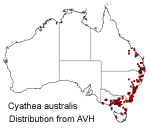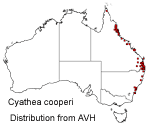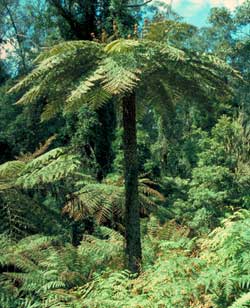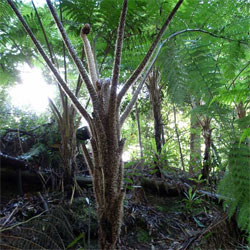Cyathea australis
Rough Tree Fern
Cyathea cooperi
Lacy Tree Fern
Cyathea australis (R.Br.) Domin
Cyathea cooperi (Hook. ex F.Muell.) Domin
Tree-ferns are the largest of the ferns and can provide a spectacular addition to most gardens. The tree-ferns Cyathea australis and Cyathea cooperi are commonly grown in gardens and displays for this aesthetic appeal and their hardiness. Both of these species are of the fern family Cyatheaceae.
C. australis is commonly known as the Rough Tree Fern due to the presence of adventitious roots, tubercles (knobbly bits) and masses of hair-like scales on its ‘trunk’. The ‘trunk’ like structure on a tree-fern is actually a greatly enlarged rhizome! The horticultural appeal of C. australis is not only due to its beautiful looks but also because it is an extremely hardy species, even capable of tolerating direct sun when the roots are wet. It is also a robust tub plant and is unusual in that it is tolerant of salty winds. C. australis is thus a popular, cold-hardy tree-fern, adaptable to a variety of climates and soils.
C. cooperi, the Lacy Tree Fern, derives this name from its delicate fronds. It is also known as the Australian Tree Fern as it is one of the most commonly grown Australian tree-ferns.
C. cooperi is quite distinctive from C. australis in that it has a more slender trunk with distinctive "coin spots" where old fronds have broken off the trunk. C. cooperi fronds are bright green and lacy and tend to be very fast growing. There are several major horticultural varieties of this fern including Cyathea ‘Brentwood’ which has paler fronds and scales and C. ‘Robusta’ which tends to be darker in both characters. C. cooperi is the one of the most popular tree ferns, along with Dicksonia antarctica due to its rapid growth form, hardiness and aesthetic appeal.
Distribution:
C. australis is found along much of the east coast of Australia, extending right down into Tasmania. It prefers moist mountain areas and can grow on dryer slopes then most other tree ferns.
C. cooperi is naturally found in tropical lowlands, along the coast of Queensland and New South Wales.
 |
 |
Propagation:
These two species cannot be propagated vegetatively (unlike some other tree-ferns)
as they do not produce offsets from the trunk or roots. Propagation from spores
must therefore be employed; for detail of these steps please see this page: http://www.anbg.gov.au/ferns/fern.spore.prop.html
Maintenance
Tree-ferns grow best in high humidity and high soil moisture conditions. It is therefore important to use good-quality mulches and to top them up regularly as this will not only keep the soil moist but also provide nutrients to the shallow root system. Tree-ferns usually respond well to organic fertilizers and well-rotted animal manures, C. cooperi especially as it tends to display particularly vigorous growth.
Though a wide range of pests attack ferns they rarely cause significant damage. If outbreaks do occur tree-ferns can be treated with the standard array of organic and non-organic pesticides. It has been found that the use of fertilizers can reduce a tree-ferns susceptibility to attack. Thus by providing adequate food, water and shelter you will be able to grow beautiful and healthy tree-ferns in your own garden!
Text by Ali Heydon (Botanical Intern 2003)
Derivation of the names:Cyathea - from the Greek 'kyatheion' meaning little cup, referring to the structure that holds the spores. australis - means southern, or 'of the southern hemisphere'. cooperi - named by Ferdinand von Mueller in honour of Sir Daniel Cooper (1821-1902). Cooper was a Member of the old New South Wales Legislative Council from 1849 and of the new Legislative Assembly after responsible self-government was granted in1856. He was elected the first Speaker of the Legislative Assembly and held that office until his resignation in1860. |
References
Jones, D.L. 1987, Encyclopaedia of Ferns, Lothian, Melbourne.
Jones, D.L. Clemesha, S.C. 1980, Australian Ferns and Fern Allies, Reed, Wellington.
Harvey, R. Fagg, M. Growing ferns from spores, Australian National Botanic Gardens leaflet published online at:
http://www.anbg.gov.au/ferns/fern.spore.prop.html
Updated 18 July, 2002.Ian Barclay, Cold Hardy Tree Ferns, Published Online at:
http://www.angelfire.com/bc/eucalyptus/treeferns/
Last updated: December 8th, 2002.
![An Australian Government Initiative [logo]](/images/austgovt_brown_90px.gif)



